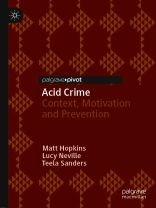This book provides an authoritative overview of the contemporary phenomenon widely labelled as ‘acid attacks’. Although once thought of as a predominantly ‘gendered crime’, acid and other corrosive substances have been used in a range of violence crimes. This book explores the historical use of corrosives in crime, legal definitions of such attacks, the contexts in which corrosives are used, victim characteristics, offender motivations for carrying and decanting corrosives, and preventative strategies. Data is drawn from the international literature and the analysis of primary data collected in the UK (which is thought to have one of the highest rates of acid attacks in the world) from interviews with over 20 convicted offenders and from police case files relating to over 1, 000 crimes involving corrosive substances. This book adds significantly to the international literature on weapons carrying and use, which to date has predominantly focused around the possession and use ofguns and knives.
Table of Content
1: Acid attacks and corrosive crime: an Introduction.- 2: Methodologies for researching acid attacks and corrosive crime.- 3: The contexts and characteristics of acid attacks/corrosive crime.- 4: Offender motivations for carrying and decanting acid and corrosives.- 5: The prevention of acid attacks and corrosive crime.- 6: conclusions and directions for future research/ policy.
About the author
Matt Hopkins is Associate Professor at the School of Criminology, University of Leicester, UK.
Lucy Neville is Lecturer at the School of Criminology, University of Leicester, UK. Teela Sanders is Professor at the School of Criminology, University of Leicester, UK












